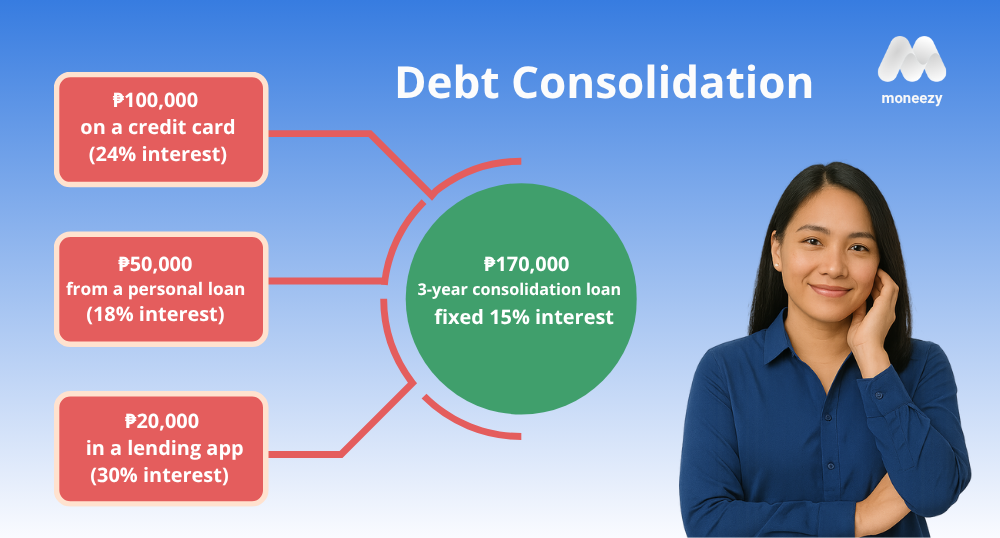Table of contents
- What is debt consolidation & how it works (with Philippine examples)
- Why Filipinos choose to consolidate their dept
- Types of debt consolidation options in the Philippines
- 1. Personal / Consolidation Loans (Unsecured)
- 2. Balance Transfer / Credit Card Promotions
- 3. Secured Consolidation (Home Equity / Auto / Property)
- Illustrative example of dept consolidation
- Key benefits & risks to consider
- Benefits of loan consolidation:
- Risks & Pitfalls:
- Step-by-Step: How to apply for debt consolidation in the Philippines
- Conclusion
Many Filipinos struggle with juggling multiple debts: credit card balances, salary loans, online lending apps, personal loans, etc. It’s easy to become overwhelmed by different due dates, varying interest rates, and mounting penalties. The mental load alone can be a major source of stress.
Debt consolidation can offer relief by combining these obligations into a single, more manageable loan or repayment plan, ideally with lower interest or clearer terms.
What is debt consolidation & how it works (with Philippine examples)
At its core, debt consolidation is the process of replacing two or more existing debts with a single new loan. Instead of paying multiple lenders on different dates, you are left with just one instalment to manage.

Why Filipinos choose to consolidate their dept
Simplified payments: You replace several monthly bills with just one, making it easier to track and pay on time.
Lower interest rates: The new loan may have a lower average interest rate than your current debts, which can save you a significant amount of money over time.
Avoid penalties: With only one due date to remember, you lower your risk of missing payments and incurring late fees and penalties.
Improved credit score: Consistently paying your single, consolidated loan on time demonstrates financial responsibility and can help improve your credit score.
But be careful: While a lower monthly payment is a major benefit, consolidation often extends your repayment period.
This could lead to paying more in total interest over the life of the loan.
Types of debt consolidation options in the Philippines
In the Philippines, common consolidation approaches include:
1. Personal / Consolidation Loans (Unsecured)
This is the most common option. You take out a new loan from a bank or lending company to pay off your existing, high-interest debts. You’re left with one instalment.
Pros: No collateral required. If you have a strong credit history and a stable income, you can secure relatively competitive rates.
Cons: Interest rates are higher compared to secured loans. Approval is highly dependent on your creditworthiness.
2. Balance Transfer / Credit Card Promotions
This is a popular option for credit card debt. You move the balance from one or more high-interest credit cards to a new card, often with a low or 0% promotional interest rate for a specific period (e.g., 6 to 24 months).
Pros: Offers immediate interest relief during the promotional window.
Cons: Once the promo period ends, any remaining balance may revert to a very high rate. This requires strict discipline to pay off the balance within the promo window.
3. Secured Consolidation (Home Equity / Auto / Property)
This method involves borrowing against an asset you own, such as your house, car, or other property, to consolidate your unsecured debts.
Pros: Secured loans have significantly lower interest rates and can offer much longer repayment terms.
Cons: This option comes with the serious risk of losing your collateral if you fail to make your payments.
Illustrative example of dept consolidation
Suppose Maria from Manila has:
₱100,000 on a credit card (24% interest)
₱50,000 from a personal loan (18% interest)
₱20,000 in a lending app (30% interest)
Maria struggles to track three different due dates and feels overwhelmed by the high, blended interest rate. She applies for a 3-year consolidation loan for ₱170,000 at a fixed 15% interest. She uses the new loan to pay off all her old debts.

Over the next 36 months, Maria has only one monthly installment to manage. Her payment is more affordable, and by consistently paying on time, she will improve her credit score.
Key benefits & risks to consider
Benefits of loan consolidation:
Simplified finances: One single due date and one monthly payment.
Potential for cost savings: A lower interest rate on the new loan can save you money over the long run.
Credit score improvement: Making consistent, on-time payments on your new loan can help rebuild your credit history.
Less financial stress: With a clear repayment plan, the day-to-day burden of juggling multiple debts is significantly reduced.
Risks & Pitfalls:
Longer repayment period: A lower monthly payment often means you'll be paying for a longer period, which can increase the total interest paid.
New debt temptation: Consolidating can free up credit limits on old accounts, which may create a temptation to accrue new debt. Discipline is crucial to avoid a new debt cycle.
Hidden fees: Watch out for fees for loan origination, processing, or prepayment penalties that can add to the total cost.
Consolidation Scams: Be extremely cautious of companies that promise to "erase your debt," ask for a large upfront fee, or tell you to stop paying your current creditors. Only work with SEC-registered lenders and banks authorized by Bangko Sentral ng Pilipinas (BSP).

Step-by-Step: How to apply for debt consolidation in the Philippines
List all your debts: Create a detailed list of every debt you have, including the creditor, outstanding balance, interest rate, due date, and any penalties.
Get your credit report: Request a copy of your credit report from the Credit Information Corporation (CIC) to understand your current credit standing.
Estimate the benefit: Use a loan calculator to compare the total cost of your current debts versus a potential consolidated loan.
Check multiple lenders: Approach several banks or lending companies. Compare their interest rates, terms, and fees to find the best offer for you.
Prepare your documents: Gather all the required paperwork, including government-issued IDs, proof of income (payslips, ITR), and statements from your current debts.
Apply and pay off old debts: Submit your application. Once approved, use the new loan proceeds to fully pay off all your previous debts. Ensure that all old accounts are officially closed.
Begin repayment: Automate your payments and monitor your balance to ensure you stay on track.
Avoid new debt: This is the most critical part. Do not open new credit cards or take on new loans while you are paying off your consolidated loan.
Conclusion
Debt consolidation in the Philippines is a great idea, but one that must be handled with care, awareness, and legal knowledge. When done properly, loan consolidation can simplify your finances, lower your payment burden, and help you reclaim control. But poor execution or dealing with unlicensed lenders can worsen your situation.

Desi Rasmussen is a FinTech Communication Specialist with more than eight years of experience in FinTech and SaaS industries. She holds a degree in International Marketing and Communication from the University of Southern Denmark and is passionate about writing content that empowering readers to make smart financial choices.
